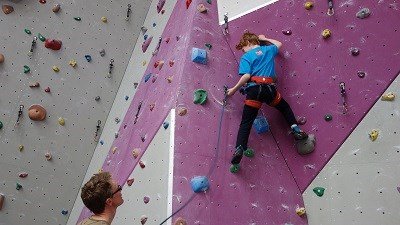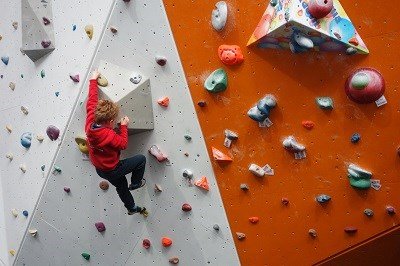


Indoor (Roped) Climbing
Climbing with ropes can be done indoors and usually involves two people, but it can also be done in a group. The person climbing the “route” is tied to a rope controlled by another person. Controlling the rope is called belaying and the person controlling the rope is the belayer.
Within this, there are two main ways of climbing indoors with ropes: top roping and lead climbing. There is also speed climbing and indoor dry-tooling, included here for completeness.
Top Roping
Top roping is where the climbing rope is already in place. The rope is threaded through an anchor at the top of the climbing wall. The person climbing “ties in” to one end of the rope, and the belayer manages the other end of the rope, taking in the slack as the climber ascends the climbing wall. True top-roping involves the belaying being at the top of the climbing wall. In reality, most belayers are at ground level so this is also referred to as bottom-roping. We use top-roping as our phrase throughout NICAS as it’s the one most commonly recognised.
Lead Climbing
Lead climbing is a more advanced technique where the climber manages the rope themselves as they climb, clipping it as they move up the route (so it is not already threaded through an anchor before they start climbing). They may clip into quickdraws, which are special snap-gate clips attached to the wall, many times on one single ascent. The belayer also needs to work in a more advanced way, ensuring the climber has enough rope to reach and clip safely but also not too much rope in case the climber falls. For the belayer, learning the right amount of rope to pay out, take in, or keep in tension, is an advanced skill so that the climber can work effectively.
Speed Climbing
Speed climbing is just what it says – climbing a route as fast as possible. This is a competitive type of climbing which can be done individually or as a team. It is not currently part of our NICAS syllabus. Speed climbing, lead climbing and bouldering formed the three disciplines of competition climbing at the 2020 Olympics. In 2024 it will be it’s own discipline.
Indoor Dry-Tooling
Indoor dry-tooling traditionally involves climbing rock with ice axes and either crampons or rock shoes. It can also be performed indoors, for example with the use of a special ice axe that has rubber loops on the ends instead of a sharp pick. The rubber loop can be hooked over the existing holds of an indoor wall without damage to the wall or danger to the climber.
Outdoor (Roped) Climbing
Our schemes are about climbing on artifical climbing surfaces, such as indoor climbing walls. The schemes provide the skills to move to climbing outdoors on real rock as well. Types of outdoor climbing:
Sport Climbing
Sport climbing is where fixed protection points such as bolts are already placed in the rock for climbers to clip quickdraws into as they work their way up the climbing route. This is effectively Lead Climbing, outside, and is a natural progression when people move from indoor to outdoor climbing.
Trad Climbing
Trad (traditional) climbing is where the first climber, the ‘lead’, places their own temporary/removable protection as they climb,rather than the fixed protection points (e.g bolts) used in sport climbing. Their partner, the ‘second’, removes the protection while they are ‘seconding’ the route. In this way, the rock face is left in its natural state after the climb is completed.
Other Climbing
Ice climbing, dry-tooling, mountaineering, solo climbing, hill walking and scrambling are also all under the umbrella of “climbing” – these are outlined in the BMC’s “types of climbing” article.
Bouldering (Indoor and Outdoor)
Bouldering is a form of climbing usually practised on small rocks and boulders, on artificial outdoor climbing structures, or at indoor walls. As the climber doesn’t go very high (hence, no need for ropes) it can be possible to jump back down, though it is recommended where possible to “downclimb” in order to descend as safely as possible.
There are limits on how high indoor/artificial boulders can be, depending on whether the boulderer has to downclimb, or whether they can exit by climbing over the top of the boulder.
Boulderers use padded mats to reduce the impact on their bodies when landing or falling. When indoors, thick padded mats are usually in place underneath the bouldering walls. These might be portable and are put in place for bouldering if they need to be stored elsewhere until use. When outside, you will often see boulderers carrying their own mats which they use for their own protection, and also to protect the ground from erosion.
Bouldering routes are called boulder problems, or blocs. When a boulder problem/bloc involves going sideways along a climbing surface, it is called a traverse.
